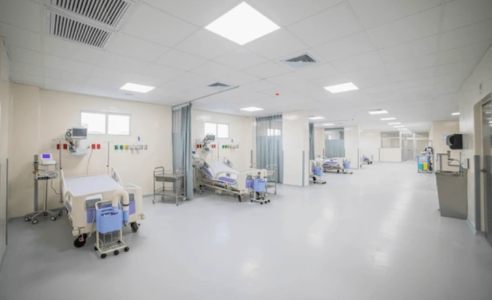Medicare urgent care clinics spark debate: Game-changing fix or temporary cover-up?
By
Gian T
- Replies 0
If you’ve tried to book a GP appointment lately, you’ll know it’s not as easy as it used to be.
Many of us have found ourselves waiting weeks for a slot with our regular doctor, or worse—facing the dreaded choice between an extended wait in a crowded emergency department or simply soldiering on and hoping for the best.
However, in recent years, a new option has emerged: are these clinics the answer to our healthcare woes, or are they just a quick fix for a much bigger problem?
Medicare urgent care clinics are walk-in medical centres designed to treat non-life-threatening conditions that still need prompt attention—think sprained ankles, minor fractures, infections, or high fevers.
They’re open seven days a week, 365 days a year, often from early morning until late at night.
The idea is to provide a middle ground between your local GP and the hospital emergency department, offering fully bulk-billed care for urgent issues when your regular doctor isn’t available.
These clinics are staffed by GPs and nurses with extra training in urgent and emergency care, and many are equipped with X-rays and other diagnostic services.
In fact, they look and feel a lot like a mini emergency department, but without the long wait times or the hefty hospital bills.
The Albanese government began rolling out urgent care clinics in 2023, and there are now 87 nationwide.
The goal is to take pressure off overcrowded emergency departments and make it easier for Australians to get timely care for urgent, but not life-threatening, health issues.
According to government data, nearly half of the people who use these clinics say they would have otherwise gone to the emergency department—especially after hours, when GPs are closed.
If Labor is re-elected, they’ve promised to invest $644 million to open another 50 clinics, aiming to have 80 per cent of Australians within a 20-minute drive of one.
The Coalition, for their part, has pledged to keep all existing clinics and open more, though they haven’t specified how many.
Let’s look at a real-life example. Chloe*, a primary school teacher from Sydney, rolled her ankle on the weekend.
She couldn’t get in to see her GP (booked out for three weeks!) and dreaded the thought of waiting for hours in the emergency department.
Instead, she visited her local urgent care clinic, where she was seen quickly, had an X-ray, and got the care she needed—all bulk-billed.
Stories like Chloe’s are becoming more common as awareness of urgent care clinics grows.
According to the government’s interim report, 1.3 million patients have used the service so far, and hospitals in areas with a UCC have seen a noticeable drop in non-urgent emergency presentations—up to 20 per cent in some places.
From a financial perspective, urgent care clinics seem to make sense.
The average cost per visit is about $246.50, less than half the $616 it costs for a similar visit to the emergency department.
That’s a saving of around $368 per patient, which adds up quickly.
As more people use the clinics and as they become more efficient, experts expect the cost per visit to drop even further.
Plus, with the government’s recent boost to Medicare funding and bulk-billing incentives, more clinics are able to offer free care to patients.
Not everyone is convinced that urgent care clinics are the answer to Australia’s healthcare challenges.
Some health experts worry that they’re just a temporary fix for deeper problems, like the shortage of GPs, the rising cost of healthcare, and the decline in bulk-billing rates.
Dr Charlotte Hespe, a GP and researcher, points out that urgent care clinics don’t address the need for ongoing, continuous care—especially for people with chronic conditions.
She argues that by funnelling patients away from their regular GP, we risk losing the benefits of long-term doctor-patient relationships and preventive care.
Others, like Dr John Adie from the University of the Sunshine Coast, are more optimistic.
He notes that similar clinics have worked well in New Zealand for decades, helping to keep emergency departments free for the most serious cases.
But he also cautions that clinics need to be used appropriately—not as a convenient way to get a repeat prescription or a check-up that a regular GP could handle.
One of the health system's biggest challenges is the decline in bulk billing, which has made it harder for many Australians—especially pensioners and those in regional areas—to afford regular GP visits.
The government has responded with an $8.5 billion boost to Medicare, tripling the bulk-billing incentive and offering extra payments to clinics that bulk-bill all patients.
Andrew Cohen, CEO of ForHealth (which runs many UCCs), says these changes are making it possible to expand bulk billing and improve access to care, especially in areas where the system has been under strain.
For older Australians, the rise of urgent care clinics could be a real game-changer.
If you’ve ever struggled to get a timely GP appointment or faced a long wait in the emergency department, these clinics offer a new, accessible option for urgent health needs—without the out-of-pocket costs.
However, it’s important to remember that urgent care clinics do not replace your regular GP, especially if you have ongoing health issues or complex needs.
They’re best used for one-off problems that need quick attention, not for managing chronic conditions or getting preventive care.
Urgent care clinics are best used for minor health issues that need quick attention but aren't emergencies, such as infections or sudden illnesses.
It's essential to inform your GP about any visits, particularly if you have ongoing conditions.
Before heading in, check the clinic’s hours and location, as they often offer extended availability.
Don’t forget to bring your Medicare card, as all services are bulk-billed.

Have you used a Medicare urgent care clinic? Did it save you time and hassle, or do you prefer your regular GP? Do you think these clinics are the answer to our healthcare challenges or just a temporary fix? Share your experiences and thoughts in the comments below.
Many of us have found ourselves waiting weeks for a slot with our regular doctor, or worse—facing the dreaded choice between an extended wait in a crowded emergency department or simply soldiering on and hoping for the best.
However, in recent years, a new option has emerged: are these clinics the answer to our healthcare woes, or are they just a quick fix for a much bigger problem?
Medicare urgent care clinics are walk-in medical centres designed to treat non-life-threatening conditions that still need prompt attention—think sprained ankles, minor fractures, infections, or high fevers.
They’re open seven days a week, 365 days a year, often from early morning until late at night.
The idea is to provide a middle ground between your local GP and the hospital emergency department, offering fully bulk-billed care for urgent issues when your regular doctor isn’t available.
These clinics are staffed by GPs and nurses with extra training in urgent and emergency care, and many are equipped with X-rays and other diagnostic services.
In fact, they look and feel a lot like a mini emergency department, but without the long wait times or the hefty hospital bills.
The Albanese government began rolling out urgent care clinics in 2023, and there are now 87 nationwide.
The goal is to take pressure off overcrowded emergency departments and make it easier for Australians to get timely care for urgent, but not life-threatening, health issues.
According to government data, nearly half of the people who use these clinics say they would have otherwise gone to the emergency department—especially after hours, when GPs are closed.
If Labor is re-elected, they’ve promised to invest $644 million to open another 50 clinics, aiming to have 80 per cent of Australians within a 20-minute drive of one.
The Coalition, for their part, has pledged to keep all existing clinics and open more, though they haven’t specified how many.
Let’s look at a real-life example. Chloe*, a primary school teacher from Sydney, rolled her ankle on the weekend.
Instead, she visited her local urgent care clinic, where she was seen quickly, had an X-ray, and got the care she needed—all bulk-billed.
Stories like Chloe’s are becoming more common as awareness of urgent care clinics grows.
According to the government’s interim report, 1.3 million patients have used the service so far, and hospitals in areas with a UCC have seen a noticeable drop in non-urgent emergency presentations—up to 20 per cent in some places.
From a financial perspective, urgent care clinics seem to make sense.
The average cost per visit is about $246.50, less than half the $616 it costs for a similar visit to the emergency department.
As more people use the clinics and as they become more efficient, experts expect the cost per visit to drop even further.
Plus, with the government’s recent boost to Medicare funding and bulk-billing incentives, more clinics are able to offer free care to patients.
Not everyone is convinced that urgent care clinics are the answer to Australia’s healthcare challenges.
Some health experts worry that they’re just a temporary fix for deeper problems, like the shortage of GPs, the rising cost of healthcare, and the decline in bulk-billing rates.
Dr Charlotte Hespe, a GP and researcher, points out that urgent care clinics don’t address the need for ongoing, continuous care—especially for people with chronic conditions.
Others, like Dr John Adie from the University of the Sunshine Coast, are more optimistic.
He notes that similar clinics have worked well in New Zealand for decades, helping to keep emergency departments free for the most serious cases.
But he also cautions that clinics need to be used appropriately—not as a convenient way to get a repeat prescription or a check-up that a regular GP could handle.
One of the health system's biggest challenges is the decline in bulk billing, which has made it harder for many Australians—especially pensioners and those in regional areas—to afford regular GP visits.
Andrew Cohen, CEO of ForHealth (which runs many UCCs), says these changes are making it possible to expand bulk billing and improve access to care, especially in areas where the system has been under strain.
For older Australians, the rise of urgent care clinics could be a real game-changer.
If you’ve ever struggled to get a timely GP appointment or faced a long wait in the emergency department, these clinics offer a new, accessible option for urgent health needs—without the out-of-pocket costs.
However, it’s important to remember that urgent care clinics do not replace your regular GP, especially if you have ongoing health issues or complex needs.
Urgent care clinics are best used for minor health issues that need quick attention but aren't emergencies, such as infections or sudden illnesses.
It's essential to inform your GP about any visits, particularly if you have ongoing conditions.
Before heading in, check the clinic’s hours and location, as they often offer extended availability.
Don’t forget to bring your Medicare card, as all services are bulk-billed.
Key Takeaways
- Medicare urgent care clinics have been rapidly expanded across Australia, providing bulk-billed, walk-in care for urgent but non-life-threatening issues, aiming to relieve pressure on busy hospital emergency departments.
- Almost half of the patients using urgent care clinics would otherwise have gone to an emergency, suggesting the clinics are meeting an important need, especially after hours and for patients who can't get timely GP appointments.
- While interim data show urgent care clinics cost the government less per presentation than emergency departments, some health experts argue there is not enough long-term evidence that they are consistently achieving their goals or located in the best areas.
- The roll-out of urgent care clinics comes amid wider concerns about the affordability and accessibility of general practice in Australia, with additional Medicare funding and bipartisan policies aiming to increase bulk billing and strengthen the primary care system overall.








